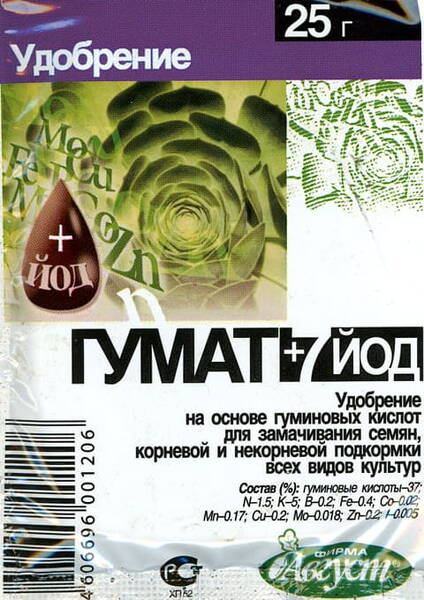Fertilizer based on humic acids for pre-sowing treatment and plant nutrition (80% humic acid salts).
* Increases germination and vigor of seed germination.
* Improves structure and increases soil fertility.
* Provides high yields.
* Increases the accumulation of nutrients and vitamins in fruits.
* Economical: 10 g of the preparation per 100 liters of water.
* The use of humates is necessary for all types of soils and for all types of plants. When using manure or plant residues for composting, it must be borne in mind that humates promote the growth of microflora and, first of all, actinomycetes (microorganisms that combine the properties of fungi and bacteria), and they are capable of destroying wood residues (cellulose, hemicellulose, proteins and lignin ), thereby accelerating the processes of natural accumulation of humus. 3 months before applying to the soil, it is useful to process manure, humus and composts with a solution of humates at the rate of 8-10 kg of humate per 10 tons of manure or 25 kg of humate per 10 tons of compost, which makes it possible to speed up the process of composting and reduce their consumption.
When is humates used?
Annual plants react more strongly to the introduction of humate at the beginning of their development and at the time of the formation of reproductive organs. Woody - after transplanting seedlings and seedlings, when the root system is injured. The same applies to vegetable and ornamental seedlings. Humates are used at all stages of plant development. Start by soaking the seeds. To do this, it is recommended to prepare a solution of 0.5 g per 1 liter of water and soak the seeds in it for a day. Soaking of summer plants (asters, verbena, salvia, petunia, nasturtium, anhirrium, carnation), as well as "babies" of gladioli, balsam cuttings, physalis, dahlias, hydrangeas should be done within 24 hours at a temperature of 20-22 degrees. Further processing with humates is carried out during the growing season. In this case, the consumption of humate is largely determined by the nature of the plant.
Crops such as dill, parsley, lettuce, onion, radish, radish and sorrel are low in nutrients. Therefore, it is enough to water them 3-4 times over the summer with a 0.01% solution, using 2-3 liters per 1 sq. meter.
Cucumbers and tomatoes are medium nutrient intakes. They are watered with a 0.01% solution of humates when planting seeds and then regularly after 2 weeks. At the same time, for tomatoes, if, after planting the seedlings, the stem thickens strongly and the size of the leaves increases, it is better to use humate by spraying the peduncles, and not to give it under the root.
All types of cabbage, peppers, carrots, beets, squash and squash require a high level of nutrients, therefore it is recommended to water once a week.
For fruit and berry crops, foliar feeding with humate is recommended at least 6 times per season: before the leaves open, in the budding phase, after flowering, when the flower buds are laid and (twice) in the phase of intensive fruit growth.
Tree seedlings and seedlings are treated with humate during transplantation, soaking the roots of the cuttings during the day, dipping them into the humate solution for 13 lengths at a temperature not lower than + 20 ° C, and then watered a week after planting.
How to use humates?
The correct use of humates is the key to success. Humic preparations are effective only in strictly defined doses, and if they are exceeded, the plants slow down their growth and may even die!
There are three options for processing humates: soaking or spraying seeds, foliar treatment (spraying), root treatment. We recommend the following system for the distribution of humate according to the methods of plant treatment. Based on the following humate consumption rates for each type of plant, first allocate 2-3% of the total dose for seed treatment, then determine the maximum amount of humate that you are able to add by foliar feeding - by spraying, the rest of the humate can be used for root feeding ...
* Recommended consumption rates of HUMATE for various crops:
Cereals (wheat, rye, oats, barley, etc.) 2-5 kg / ha.
Vegetables (cucumbers, tomatoes, peppers, eggplants, etc.) 7-10kg / ha.
Root crops (potatoes, beets, carrots, etc.) 5-15 kg / ha.
Berries (strawberries, wild strawberries, currants, etc.) 8-12 kg / ha.
Industrial crops (cotton, rapeseed, etc.) 4-6 kg / ha.
Fruits (apple, cherry, plum, citrus) 10-15 kg / ha.
Melons (watermelons, melons) 5-7 kg / ha.















